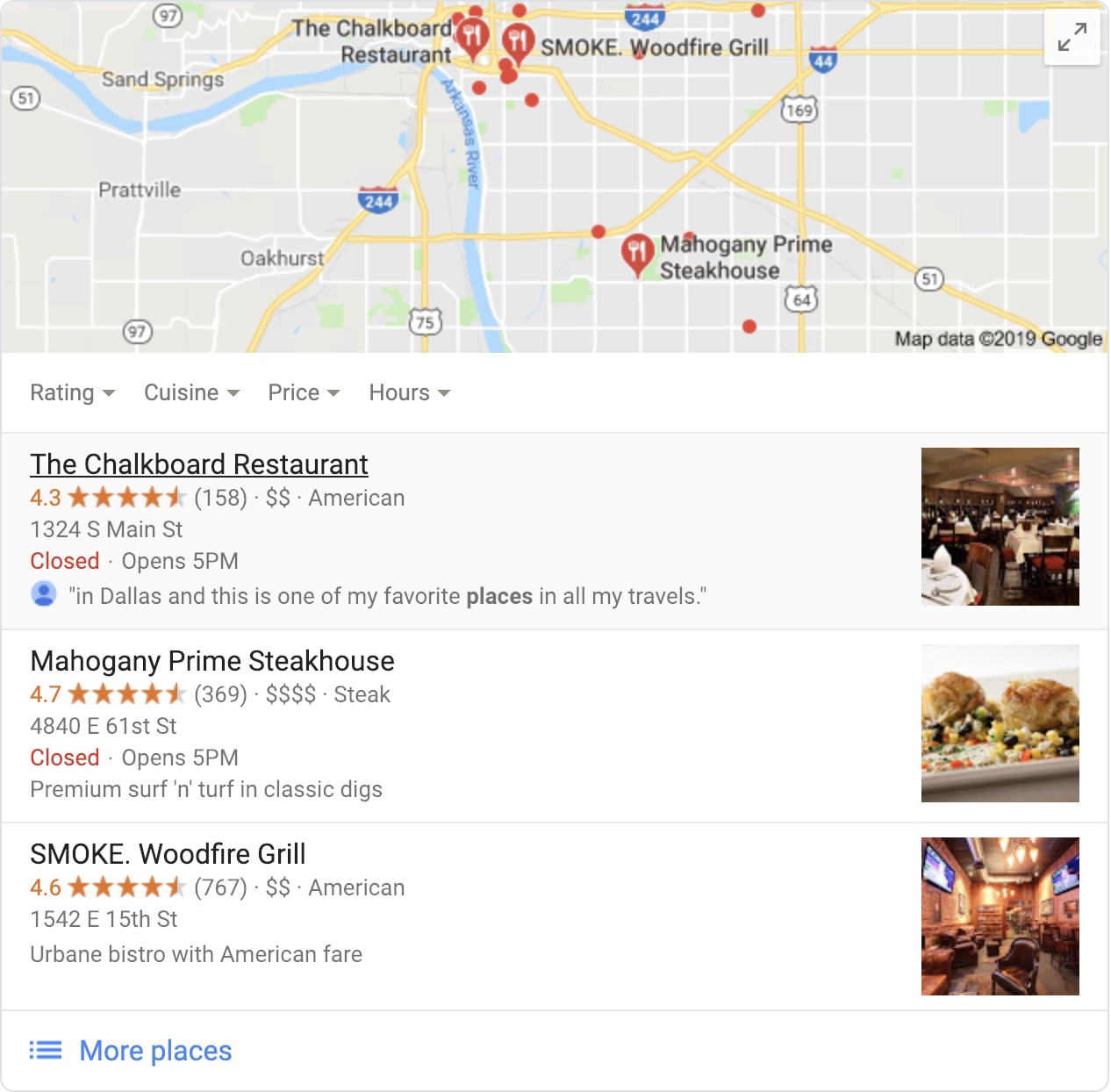Retail firms and businesses can get close to a 30% increase in the volume of organic traffic by employing structured markup. Schema markup is a code that is placed on your website with the goal of helping search engines return additional informative results for the users.
Statistics show that on average, websites using schema markup rank four positions higher in terms of Search Engine Results Pages (SERPs) than those without. Yet, over 50% of companies featured on Fortune 500 are not using Schema markup!
It is vital if your website is to rank higher in SEO or get higher conversion rates that you add schema structured markup to the “Home” or “About” page of your company. Also known as structured data, it informs search engines not just what your data says but what it means.
Types of Schema Markup
On your website, a structured markup not only makes sense from a purely technical perspective but also adds credibility to your business listings. That way, it also helps in improving your local SEO.
There are different types of schema markup. It will be upon you to select the type most suitable for your website based on the nature of the business you are running. You may, for example, pick one that highlights location if that is important for your business while another business may opt for another aspect of Name, Address, and Phone (NAP).
Once you have identified what your page is about, pick a Schema Markup class and proceed to describe it. Once all this information has been mapped out, put it into an appropriate Schema Markup code. The code is available in several formats: RDFa, Microdata, and JSON-LD. Always ensure that you double check your Schema markup before uploading.
Schema Markup and SEO
The context in which a search engine will interpret a query determines the quality of the response or result. Structured data or schema markup is capable of providing context to a webpage that would otherwise be ambiguous. Basically, structured data (schema markup) is a special language of the search engines and has been used by Google, Yandex, Yahoo!, and Bing since 2011.
Found at Schema.org, Schema markup is basically a type of microdata. This is a set of tags whose goal is to create annotating HTML elements with tags that are machine-readable. Schema Markup essentially boosts your business metrics and improves your SEO. Once you add schema data to your webpage, it creates rich snippets (enhanced descriptions), which start appearing in search results.
Although no evidence is available to show that microdata directly impacts organic search rankings, rich snippets are known to give WebPages more prominence in SERPs. The subsequent better visibility boosts click-through rates (CTRs). One particular study found a session increase of 516% with the CTR rising to 8% from 2% while organic visitor revenue rose by 677% following consistent snippet featuring.
Schema Markup and Local SEO
As you work on improving your local SEO, you should also be working on a structured data markup. This is because local businesses can boost their local SEO efforts when they employ Schema.org markup.
Adding the schema markup code helps the search engines to identify specific text details on your website. This includes name, address, and phone number. Structured data allows search engines to have a better understanding of your NAP data. This consequently lets them present your data in a more user-friendly manner in the rich snippets or data.
Recommended: Local SEO: A Comprehensive Guide to Boosting Your Local Search Rankings in 2019
Why is Schema Markup Important?
When a website has schema markup, users can see what your site is all about in the Search Engine Results Pages. This includes what you do, where you are located, your price range, plus lots of additional useful stuff. Some people even refer to schema markup as the “virtual business card.”
Schema markup helps search engines like Google to understand your product offerings details better and thus showcase them in a more positive way for the benefit of the user/reader. Schema markup also impacts SEM strategies so that they can provide more relevance to an incoming search query thus increasing your quality score. This estimates the quality of your landing pages, keywords, and ads.
Rich Search Results: Businesses adopting structured data get rewarded with ‘rich results’ or rich snippets in searches. The rich results can range from local business information, ratings, product information, CTAs to information panels. Your website will start appearing at the top of the leading search engine result page, even before the standard organic listings.
E-Commerce stores that use structured data can get rich SERP results such as pricing, star ratings, and store availability to give the user a better online experience. This according to GoogleIO 2017 can lead to a higher click-through rate of between 30-84%. That is why Google recommends the optimization of products using schema markup.
Increase Conversion Rates: When your site has rich snippets, it may also boost your conversion rates. As more people see your positive listings, the possibility of their buying from you increases.
Higher CTR: Having rich snippets showing up in the SERPs for your products is an excellent way of increasing click-through rates. It also draws additional attention to your listings, particularly when you are receiving great product reviews.
Although just adding schema markup doesn’t mean that your website will automatically start ranking better, it certainly simplifies the work of search engines when it comes to interpreting your content. This makes it easier for leading search engines to include such information when responding to related search queries. So, effectively, you will be placing your website in pole position by incorporating relevant microdata as it enhances your search results.
Setting Up Schema Markup
Schema data markup employs a unique microdata format. You, however, will not be required to learn or master any new skills in coding as web pages using schema data markup still use the HTML format. The only difference comes in terms of adding bits of unique schema.org vocabulary to your site’s HTML Microdata.
While it may take a little more time and a bit of learning during the implementation, you will find that eventually, it is quite beneficial for increasing conversions and building loyalty.
1. First, compile a list of all the schemas in common use to identify the one best suited for your needs. If your web pages only have a few items that need markup, Google offers a unique tool located within the Search Console that allows you to quickly and conveniently click‐and‐drag items.
2. Second, locate all schema types which you think will be useful towards achieving your SEO goals.
3. Third, mark up and ensure that only content visible to your visitors is marked-up. Don’t mark up content which is hidden in page element as it will not help your objectives in terms of results.
4. Lastly, take your time in perfecting the markup code. When you feel it’s ready for deployment, run it through Google’s Structured Data Tool. To simplify the code uploading process, always stick to Google’s custom HTML tag available from Google’s Tag Manager.
Implementing Schema Markup
When you add structured data to your HTML it enhances how your web pages display in Search Engine Result Pages as it improves the rich snippets displayed below your page title. There are several ways of implementing Schema. It can be achieved with JavaScript Object Notation for Linked Data (JSON-LD) in Angular-JS framework or Resource Description Framework in Attributes (RDFa). RDFa is essentially an HTML5 extension and is designed to aid users when marking up their structured data.
JSON-LD uses JavaScript. As soon as your markup code is ready in the container, simply hit the publish button and complete the process of verification.
An interesting feature is that Google (as well as Microsoft) can also read and understand your data markup if presented in an external file designed to load after your web page has loaded. If your site is very large or makes extensive use of structured data, this is a good solution as it potentially makes the management of the schema markup data much easier.
Areas Where Schema Markup Applies
Collaboration between leading search engines Google, Yahoo!, Bing, and Yandex gave birth to Schema.org to help businesses offer the kind of information their specific search engines needed to understand what your content was all about. It's unclear if other search engines besides these four are also using Schema Markup to modify the way they are displaying their search results.
Although just a couple of years ago, structured markup was more limited in scope, today it can be used for lots of products. Today, it is widely used in providing additional information on different things such as:
• Products/Product Options
• Reviews (Big Commerce)
• Pages
• Blogs
• Creative work
• Persons
• Events
• Organizations
• Places
You can add schema markup for multiple types of content into a single HTML content page. Your news article, for example, might also have a video. Therefore, consider adding markup for both content types to ensure that your webpage is eligible for both the video and top stories carousel rich results.
When people search for a TV show or movie, their interest might actually be to take action on that specific content - such as watching that movie clip via a mobile device or booking a restaurant reservation. If your app or website is capable of handling such actions, then your schema markup data can inform Google accordingly. Google will then be in a position to send such users to your app or website.
Video Schema Markup
Serious marketers appreciate the importance of videos to business SEO. That explains why Google recommends that websites incorporate rich snippets on their unique video landing pages, even if that is a YouTube embed video. This is an excellent and useful medium when you want to rank high on search engines.
In fact, when it comes to certain search queries, content in the form of videos often tends to outrank others particularly when they are responding to “how to” type of queries. You can leverage embedded or hosted video content through VideoObject schema.
Similar to how Google displays video rich snippets for major streaming platforms such as YouTube, VideoObject schema markup helps rich snippets show up during Google Video Searches.
Caution when Using Schema Markup
Similar to any form of SEO, unfortunately, some aspects are prone to be abused. This is why you cannot afford to become spammy with your structured data. Ensure that you are only using markup data that is relevant to your website content.
Failure to follow this guideline may see your website receiving a spammy structured data manual action warning from Google. This could result in your microdata not being displayed in the SERPs until you take appropriate action to clean up your site.
Conclusion
As simple as implementing schema markup is, it’s surprising how few websites and businesses are taking advantage of it. Of course, you can expect a bit of learning when you start to use schema markup but this is an innovative SEO approach with potentially rich dividends if implemented well. It only requires a mindset capable of delivering human readable code at the same time visualizing what a search engine machine might possibly get out of it.
The benefits of schema markup including local SEO are many and businesses cannot afford to ignore them. If you have not yet implemented schema markup, there can be no better time to start than now. Doing so puts your website ahead of the curve, thus getting you vital mileage against the competition. It may appear demanding, but with the above pointers, you will be glad that you took the time and effort to incorporate structured data into your website pages.
Related Posts

William Munir is the Chief Marketing Officer of BUFF Guy Media, a digital marketing company specializing in smarter ways to live in the digital era. As a content creator and enthusiast, he enjoys spending his time learning the latest in the digital niche.







